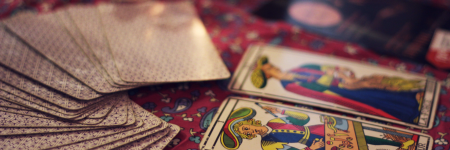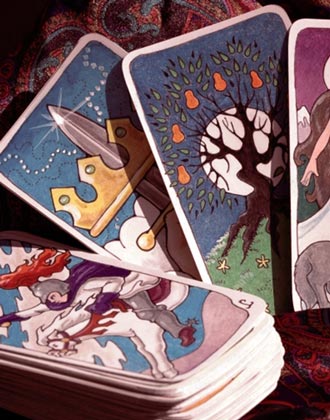
Your 2026 Conception Calendar: Luckiest Dates Revealed
Discover the most auspicious dates to conceive in 2026 based on astrological insights. Jupiter, Venus, and lunar cycles guide your fertility journey.
When studying the main 22 cards of a Tarot Card Deck (also known as the ‘Major Arcana’) it’s important to take into account their symbols, colors, and position in the game 🃏. The symbolism of a card can vary massively depending on its relationship to the other cards, which is essential to know when reading what the future has in store. What do each of the cards mean for you and your future path?

Immerse yourself in the mystical world of the Marseille Tarot, the divinatory tool par excellence. Widely used by professional readers, the Tarot de Marseille is astonishing for its precision and its ability to cut through any situation. Because we want to share our passion for the Tarot with you, we're offering you your very own Tarot reading.

Today’s Love Tarot — Instant Answers
Think of your person or your burning question, take a deep breath, and reveal today’s Tarot message



Tarot cards have been used to predict the future for thousands of years, and now the time has come for you to give it a go! Will you find peace in the cards, or is your future looking bleak? Love? Death? Conflict? Harmony? What do they have to say about the days to come?
The meaning of these cards is oriented towards self-knowledge. They offer concrete and personalized guidance that will talk to the person about their possibilities to evolve. Each card has several meanings that make up a coherent whole, based on the meaning of the symbols on the card. It's a richness that requires choosing the meaning best suited to your question or situation.
Marseille Tarot cards are widely used by professionals in the field of divination. Because we want to share our passion for tarot with you, we offer you your free tarot reading. Welcome to the mystical world of the Tarot of Marseille! Immerse yourself in the heart of an ancestral tradition with our free reading. Whether you seek answers to your deepest questions or simply want insight into your day, we are here to guide you. Let the cards reveal the secrets of your future. So, are you ready to discover what the cards have to tell you? 🤫

Love, work, projects, or health... to discover what the future holds for you, let the Marseille Tarot cards speak for you. With its 22 arcana, this deck is one of the richest and most exciting.
| Card | Keywords | Meaning |
|---|---|---|
| Justice | Balance, Honesty, Consequences | It reminds you of the importance of integrity in your decisions. |
| Devil | Temptations, Dependencies, Liberation | This card warns you against excesses. |
| Death | Transformation, Rebirth, Renewal | Embrace the end of something for a chance at new beginnings. |
| Sun | Joy, Success, Vitality | A very positive card that announces happiness and fulfillment. |
| Pope | Spirituality, Guidance, Moral Authority | It represents guidance and support in your life choices. |
| Empress | Fertility, Beauty, Abundance | She symbolizes fulfillment and material comfort. |
| Tower | Transformation, Endings, New Beginning | A reminder that the end of something is also the start of something else. |
| Lover | Love Choices, Dilemmas, Relationships | It invites you to follow your heart but with discernment. |
| Hanged Man | Sacrifice, New Perspective, Letting Go | A moment to reconsider what is truly important. |
| World | Accomplishment, Integration, Success | This card symbolizes complete realization and success. |
| Magician | New Beginnings, Opportunities, Potential | A reminder that you have the necessary tools to succeed. |
| Temperance | Moderation, Balance, Patience | It advises you to find balance in your life. |
| Judgment | Awakening, Judgment, Rebirth | It calls on you to evaluate your life and make significant changes. |
| Strength | Courage, Self-Control, Inner Power | It encourages you to confront your fears with bravery. |
| Wheel of Fortune | Changes, Cycles, Destiny | This card symbolizes the ups and downs of life and how you react to them. |
| High Priestess | Wisdom, Hidden Knowledge, Intuition | A sign to trust your instinct and inner wisdom. |
| The Fool | Freedom, Adventure, The Unknown | A reminder that sometimes, you need to dare to take risks to move forward. |
| The Emperor | Authority, Stability, Foundations | This card encourages you to take control and organize your life. |
| Star | Hope, Inspiration, Serenity | A positive sign of calm after the storm. |
| Moon | Illusions, Fears, The Unconscious | It invites you to confront your fears and clarify your vision. |
| Hermit | Reflection, Introspection, Truth | Take time to reconnect with yourself before making important decisions. |
| Chariot | Victory, Determination, Discipline | A sign that success is within reach through your perseverance. |
🔮 My tips for a successful readingFollow these simple steps to connect with the universe of the Marseille Tarot and get clear answers to your questions:
|
Decipher the wisdom of the cards 🔮
👉 Explore your tarot journey →
🔮 Let the ancient wisdom of tarot guide your path
The Marseille Tarot isn’t just a deck of cards—it’s a portal to the subconscious, a guide that connects us with ancient wisdom. With its bold imagery and rich archetypes, each card acts as a mirror to your soul. Whether you’re asking about love, career, or personal growth, the Marseille Tarot offers a no-nonsense yet deeply spiritual perspective on your current path.
Its strength lies in its ability to reveal the truth, even when it’s uncomfortable. This is not a sugar-coated reading. It's honest, raw, and incredibly helpful when you're facing crossroads in life.
Are you new to Tarot reading? The Marseille Tarot is beginner-friendly, yet its rich symbolism continues to captivate even seasoned readers. If you’re looking for a way to connect deeper with yourself and the universe, follow these tips:
The ancients believed certain hours held special divinatory power:
Read on to discover the meanings and the most powerful cards of this deck. If you’d like to learn more about what's in store for you, then discover your yearly Tarot predictions!
Frequently Asked Questions About Marseille Tarot Cards and Readings
Yes, you can absolutely read Tarot for yourself! Many people use the cards for daily reflection, journaling, and intuitive guidance. That said, connecting with a gifted reader like Ava of Light can offer deeper clarity and spiritual insight—especially when you need answers fast.
Start your reading instantly with Ava of Light and receive guidance in real time.
Marseille Tarot follows a structured system of 78 cards with deep symbolism and tradition. Oracle cards are more free-form and intuitive. Both are powerful, but Tarot offers a more detailed and time-tested framework for insight. Curious which one fits your energy best?
Connect with Ava of Light now and explore the cards that speak to your soul—no waiting, no booking.
Don’t worry—cards like The Tower or Death aren’t bad omens. They often represent transformation, breakthroughs, and necessary change. These cards can be powerful turning points in your journey. A skilled reader can help you understand their true meaning in your life.
Start a live reading with Ava of Light now and uncover the deeper message behind your cards.
Yes! Tarot is a powerful tool for clarifying your options, understanding your emotions, and exploring potential outcomes. It won’t make the decision for you—but it will help you move forward with confidence and insight.
Need clarity now? Ava of Light is available for instant readings—get answers in minutes.
There’s no single “correct” way. Some people shuffle traditionally, others spread the cards and choose intuitively. What matters most is your intention and connection to the process. Trust your instincts—they’re part of the magic.
Want to see how a pro does it? Ava of Light is online now—start your reading instantly.

Discover the most auspicious dates to conceive in 2026 based on astrological insights. Jupiter, Venus, and lunar cycles guide your fertility journey.

Discover which zodiac signs will experience true love in 2026! Cosmic predictions, coaching tips, and mantras for your heart's transformation.

Are you one of those who believe everything happens by chance or do you think your destiny is already written? You should know that the Universe, as vast as it is, is governed by 14 laws. Among them are the laws of Karma, Attraction, and Divine Unity. Discover them to take control of your life and rediscover harmony.

Discover which zodiac signs might surprise you in 2026! From impulsive decisions to emotional intensity, learn who to watch out for this year.

Neptune in Pisces exits retrograde at 7:23 AM Embrace the awakening of your dreams and let your intuition guide you through the waves of transformation.

Sun in Sagittarius Trine Moon in Leo Embrace the radiant dance of your inner light and let your spirit soar with courage and joy, for today the universe aligns to illuminate your path with warmth and inspiration.
The card reading is so right very time thanks
[email protected], 6 years ago